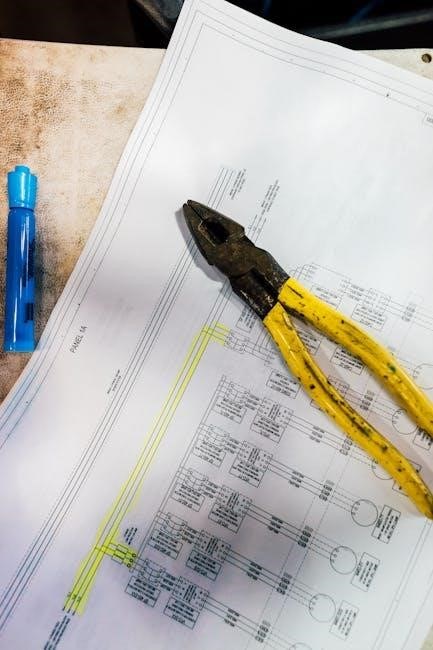The Water Supply Design Manual Uganda is a comprehensive guide developed by the Ministry of Water and Environment to standardize water infrastructure design and implementation‚ ensuring effective and sustainable water supply systems nationwide.
Purpose and Importance of the Manual
The Water Supply Design Manual Uganda serves as a critical resource for stakeholders involved in water supply projects‚ providing standardized guidelines for designing and implementing sustainable water systems. Its primary purpose is to ensure that water infrastructure meets the needs of communities while adhering to national policies and environmental standards. The manual is essential for addressing challenges such as hydrological variability‚ socio-economic disparities‚ and environmental sustainability. By offering a framework for best practices‚ it enables professionals to deliver efficient and equitable water solutions. The manual also plays a key role in building capacity among engineers‚ planners‚ and communities‚ fostering long-term water security and public health improvements across Uganda.

Key Principles of Water Supply Design
The Water Supply Design Manual Uganda outlines key principles to ensure sustainable and effective water systems. These include satisfying current and future demand‚ providing safe drinking water‚ and promoting resource sustainability. Designs must comply with national laws and environmental standards while addressing socio-economic factors. Equitable access‚ cost-effectiveness‚ and community engagement are emphasized to ensure systems meet local needs. The manual also stresses the importance of resilience to hydrological variability and climate change. By adhering to these principles‚ professionals can create water supply systems that are both functional and environmentally responsible‚ contributing to public health and economic development across Uganda. These guidelines form the foundation for all water supply projects in the country.

The Design Process
The design process involves preliminary assessments‚ demand forecasting‚ source selection‚ system design‚ implementation‚ and monitoring. It ensures a structured approach to developing sustainable water supply systems effectively.
4.1 Preliminary Assessment and Planning

The preliminary assessment and planning phase is critical in the design process. It involves understanding the context‚ challenges‚ and opportunities for water supply development. Key activities include data collection on hydrology‚ topography‚ and socio-economic factors. This phase identifies potential water sources‚ assesses demand‚ and evaluates existing infrastructure. Feasibility studies are conducted to determine the most suitable solutions. Stakeholder engagement and community participation are emphasized to ensure alignment with local needs. Environmental and cultural considerations are also integrated to promote sustainability. This phase lays the foundation for subsequent design steps‚ ensuring that solutions are context-specific and aligned with national water policies. Effective planning at this stage is essential for achieving long-term success.
4.2 Demand Forecasting and Analysis
Demand forecasting and analysis are essential steps in water supply design‚ ensuring systems meet current and future needs. This process involves estimating water demand based on population growth‚ urbanization‚ and economic activities. Key factors include per capita consumption‚ seasonal variations‚ and institutional requirements. Statistical models and scenario analysis are used to predict demand accurately. The analysis also considers socio-economic trends and land-use changes. Accurate forecasting ensures a balance between water supply and demand‚ preventing shortages or over-design. It informs the selection of appropriate technologies and system sizing. This step is critical for sustainable and efficient water supply planning‚ aligning with Uganda’s development goals and water policies.
4.3 Source Selection and Development
Source selection and development are critical in ensuring a reliable and sustainable water supply. The process involves identifying and evaluating potential water sources‚ such as springs‚ shallow wells‚ boreholes‚ and surface water bodies. Key considerations include water quality‚ quantity‚ and sustainability. Hydrological assessments are conducted to determine the yield and reliability of each source. Environmental and socio-economic impacts are also evaluated to ensure responsible development. Once a source is selected‚ appropriate technologies are applied for extraction‚ treatment‚ and distribution. This step ensures that the chosen water source aligns with the community’s needs and complies with national water policies. Proper source development is essential for long-term water security and system efficiency.
4.4 System Design and Layout
System design and layout are pivotal in creating efficient and functional water supply systems. The process involves mapping out infrastructure components such as storage tanks‚ distribution networks‚ and treatment plants. Topography‚ population distribution‚ and water demand are key factors influencing the layout. Gravity-fed systems are often preferred for their cost-effectiveness‚ while pumped systems are used where terrain or demand necessitates. Solar-powered solutions are increasingly integrated for sustainability. The design ensures equitable access to water‚ minimizing energy consumption and environmental impact. Proper layout also considers future scalability and maintenance accessibility. Adherence to national water standards and community needs ensures the system’s longevity and effectiveness. This phase is crucial for achieving a balanced and sustainable water supply solution.
4.5 Implementation and Construction
The implementation and construction phase involves translating the design into reality‚ ensuring adherence to specifications and safety standards. This stage requires careful planning‚ including material procurement‚ site preparation‚ and labor management; Local communities are often engaged to ensure acceptance and participation. Construction must comply with national water standards and environmental regulations to minimize ecological impact. Proper sequencing of activities‚ such as pipeline installation and storage tank construction‚ is essential for efficiency. Quality control measures are implemented to ensure durability and functionality. Community training on system operation and maintenance is also conducted during this phase. Successful implementation ensures the system meets current and future water needs sustainably.
4.6 Monitoring and Evaluation
Monitoring and evaluation are critical phases in ensuring the long-term functionality and sustainability of water supply systems. These processes involve regular assessments of system performance‚ water quality‚ and user satisfaction to identify and address potential issues. Data collection tools‚ such as flow meters and water testing kits‚ are used to track key indicators like water pressure‚ flow rates‚ and microbial safety. Community feedback is also essential to understand user experiences and perceptions. Evaluation reports are generated to document findings‚ highlighting successes and areas for improvement. This iterative process ensures that water supply systems remain efficient‚ reliable‚ and aligned with user needs. Continuous monitoring also supports adaptive management‚ enabling timely interventions to maintain system integrity and performance over time.

Technologies in Water Supply Systems
The manual outlines various technologies for water supply‚ including rainwater harvesting‚ springs‚ shallow wells‚ boreholes‚ gravity-fed systems‚ and pumped water supply systems‚ ensuring sustainable solutions.
5.1 Rainwater Harvesting
Rainwater harvesting is a sustainable technology promoted in the Water Supply Design Manual Uganda for enhancing water security. It involves collecting‚ storing‚ and utilizing rainwater from surfaces like rooftops and ground catchments. This method is particularly effective in areas with seasonal rainfall patterns‚ providing a reliable supplement to traditional water sources. The manual emphasizes proper design‚ including suitable storage tanks‚ gutters‚ and filtration systems‚ to ensure water quality and safety. Rainwater harvesting is cost-effective and reduces dependency on groundwater‚ making it ideal for rural and urban areas. It also supports climate resilience by utilizing a renewable resource. Proper implementation and maintenance are stressed to maximize benefits and ensure long-term sustainability of this eco-friendly water supply solution.
5.2 Springs and Surface Water
Springs and surface water are vital sources for water supply in Uganda‚ particularly in rural and hilly regions. The Water Supply Design Manual Uganda outlines guidelines for harnessing these resources effectively. Springs are natural water sources that require proper protection from contamination‚ while surface water‚ such as rivers and lakes‚ needs treatment due to potential pollutants. The manual emphasizes sustainable practices‚ including catchment protection and community involvement in resource management. Design considerations include assessing water quality‚ flow rates‚ and seasonal variations. Proper implementation ensures reliable and safe water supply systems‚ balancing environmental conservation with community needs. These technologies are cost-effective and culturally accepted‚ making them integral to Uganda’s water supply strategy.
5.3 Shallow Wells and Boreholes
Shallow wells and boreholes are widely used in Uganda for water supply‚ especially in rural areas where access to surface water is limited. The Water Supply Design Manual Uganda provides detailed guidelines for their design‚ construction‚ and maintenance. Shallow wells are typically dug by hand or with machinery‚ while boreholes are drilled to access deeper aquifers. Key considerations include hydrological assessments‚ proper siting to avoid contamination‚ and the use of durable materials. Community involvement is crucial for sustainability‚ with training on operation and maintenance. The manual also emphasizes the importance of water quality testing and protection of the surrounding environment to ensure long-term functionality. These technologies are cost-effective and adaptable‚ making them essential for rural water supply systems.
5.4 Gravity-Fed Systems
Gravity-fed water supply systems are a reliable and cost-effective solution in Uganda‚ particularly in areas with suitable topography. These systems utilize natural gravity to distribute water from a higher elevation source‚ such as a spring or reservoir‚ to lower-lying communities. The Water Supply Design Manual Uganda outlines key design principles‚ including proper site selection‚ intake construction‚ and distribution network layout. The manual emphasizes the importance of protecting water sources from contamination and ensuring the system’s sustainability. Gravity-fed systems are energy-efficient and require minimal operation and maintenance‚ making them ideal for rural and peri-urban areas. Community involvement in monitoring and upkeep is also stressed to ensure long-term functionality and water quality. This approach aligns with Uganda’s goal of expanding access to safe and reliable water supplies.

5.5 Pumped Water Supply Systems
Pumped water supply systems are essential in areas where gravity-fed systems are not feasible due to topographical constraints. These systems rely on pumps to lift and distribute water from sources like boreholes‚ wells‚ or rivers to consumers. The Water Supply Design Manual Uganda provides detailed guidelines for designing pumped systems‚ including pump selection‚ energy sources‚ and pipeline sizing. Solar-powered pumps are increasingly recommended for their sustainability and reduced operating costs. The manual also emphasizes the importance of regular maintenance to ensure system efficiency and longevity. Pumped systems are particularly useful in urban and peri-urban areas with high water demand. However‚ they require significant initial investment and skilled personnel for operation‚ making community training and involvement crucial for long-term success.
Challenges in Water Supply Design
Designing water supply systems in Uganda faces challenges like hydrological variability‚ socio-economic factors‚ and environmental considerations‚ requiring adaptive and sustainable solutions to ensure equitable access to safe water.
6.1 Hydrological Variability
Hydrological variability poses significant challenges in water supply design‚ particularly due to Uganda’s climate‚ which experiences irregular rainfall patterns and seasonal fluctuations. This variability affects both surface and groundwater sources‚ leading to periods of scarcity or excess. Designing systems that can adapt to these fluctuations is crucial to ensure consistent water availability. Climate change further exacerbates these challenges‚ making long-term planning complex. Understanding hydrological patterns is essential for developing resilient water supply systems that can withstand droughts and floods. The manual emphasizes the need for adaptive design strategies to mitigate the impacts of hydrological variability‚ ensuring sustainable water access for communities.
6.2 Socio-Economic Factors
Socio-economic factors significantly influence water supply design in Uganda‚ as they shape demand‚ resource allocation‚ and community engagement. Population growth‚ urbanization‚ and economic activities increase water demand‚ while poverty and limited infrastructure hinder access. The manual emphasizes the need to align water supply systems with local socio-economic contexts to ensure equity and sustainability. Understanding these factors helps designers prioritize communities with the greatest needs. Additionally‚ cultural practices and land-use patterns must be considered to avoid conflicts and ensure acceptance of water projects. Addressing socio-economic challenges is crucial for creating inclusive and resilient water supply systems that benefit all stakeholders.
6.3 Environmental Considerations
Environmental considerations are critical in water supply design to ensure sustainability and minimize ecological impact. The manual emphasizes the need to balance water resource development with conservation of natural habitats and biodiversity. Hydrological variability‚ climate change‚ and land-use changes pose significant challenges‚ requiring adaptive design strategies. Water projects must comply with environmental regulations and assess potential impacts on ecosystems. Sustainable practices‚ such as rainwater harvesting and solar-powered systems‚ are promoted to reduce reliance on fragile natural resources. Additionally‚ the manual advocates for the protection of water sources and surrounding areas to maintain water quality and ecological balance. Integrating environmental considerations ensures that water supply systems are resilient and harmonize with Uganda’s diverse landscapes.
6.4 Community Engagement and Participation
Community engagement and participation are essential for the success of water supply projects in Uganda. The manual emphasizes the importance of involving local communities in the planning‚ design‚ and implementation phases to ensure their needs are met and their support is garnered. This includes conducting public consultations‚ awareness campaigns‚ and training programs to educate communities about water management and conservation. Active participation ensures that water supply systems are culturally acceptable‚ socially inclusive‚ and sustainable in the long term. Local leaders and stakeholders are encouraged to take ownership of projects‚ fostering a sense of responsibility and accountability. This collaborative approach helps address socio-economic disparities and ensures equitable access to safe water‚ empowering communities to manage their water resources effectively.
Case Studies and Success Stories
The manual highlights successful water supply projects in Uganda‚ showcasing urban and rural initiatives‚ including solar-powered systems‚ that have improved access to safe water‚ benefiting communities.
7.1 Urban Water Supply Projects
The Water Supply Design Manual Uganda features case studies of successful urban water supply projects‚ demonstrating effective implementation of technologies like gravity-fed and pumped systems. These projects highlight how urban areas have achieved reliable water access‚ reducing contamination risks and improving public health. The manual emphasizes sustainable design principles‚ ensuring systems meet growing urban demands while addressing hydrological variability. Community engagement and proper maintenance are underscored as key factors in long-term success. These urban initiatives serve as models for future projects‚ showcasing the importance of integrated planning and adaptive solutions to ensure equitable water distribution.
7.2 Rural Water Supply Initiatives
The Water Supply Design Manual Uganda highlights successful rural water supply initiatives‚ emphasizing the use of technologies like shallow wells‚ boreholes‚ and rainwater harvesting. These projects focus on providing safe and sustainable water access to rural communities‚ addressing challenges such as hydrological variability and socio-economic disparities. The manual underscores the importance of community involvement in the design and maintenance of these systems‚ ensuring long-term functionality and acceptance. By integrating local resources and adapting to environmental conditions‚ rural water initiatives have significantly improved public health and livelihoods. These case studies serve as practical examples for replicating successful models in other rural areas‚ promoting equitable water access nationwide.
7.3 Solar-Powered Water Systems

The Solar-Powered Water Systems Design Manual in Uganda addresses the growing need for renewable energy solutions in water supply. Developed under a Memorandum of Understanding‚ this document guides professionals in designing‚ installing‚ and maintaining solar-powered systems. It emphasizes the importance of solar energy in reducing reliance on fossil fuels and lowering operational costs. The manual highlights how solar systems can address challenges like energy scarcity and hydrological variability‚ particularly in rural areas. By integrating solar technology with water supply infrastructure‚ Uganda aims to enhance access to clean water while promoting environmental sustainability. This initiative aligns with the country’s commitment to climate resilience and sustainable development‚ ensuring reliable water services for future generations.
Best Practices for Sustainable Water Supply
The Water Supply Design Manual Uganda emphasizes planning‚ community involvement‚ and operation and maintenance as key practices for ensuring reliable and eco-friendly water supply systems nationwide.

8.1 Planning and Design Considerations
The Water Supply Design Manual Uganda outlines critical considerations for planning and designing sustainable water systems. It emphasizes the need to balance water demand with available resources‚ ensuring long-term sustainability. Key principles include hydrological assessments‚ environmental impact evaluations‚ and compliance with national and international water quality standards. The manual also stresses the importance of community engagement during the planning phase to address local needs and preferences. Additionally‚ it advocates for the integration of climate resilience and adaptive management strategies to mitigate the effects of hydrological variability. By adhering to these guidelines‚ stakeholders can ensure that water supply systems are both efficient and equitable‚ meeting the needs of present and future generations. Proper planning is essential to avoid resource depletion and ensure system durability.
8.2 Community Involvement
Community involvement is a cornerstone of sustainable water supply design in Uganda‚ as emphasized in the Water Supply Design Manual. Active participation of local communities ensures that water systems align with their needs and priorities. The manual advocates for public consultations‚ awareness campaigns‚ and education to empower communities in managing water resources. It also highlights the importance of feedback mechanisms to address concerns and ensure transparency. By fostering a sense of ownership‚ communities are more likely to maintain and protect water infrastructure. This approach not only enhances the acceptance of water projects but also promotes equity and inclusivity‚ ensuring that all stakeholders benefit from improved water services. Effective community involvement is vital for the long-term success and sustainability of water supply systems in Uganda.
8.3 Operation and Maintenance
The Water Supply Design Manual Uganda emphasizes the importance of effective operation and maintenance (O&M) for sustainable water systems; It provides guidelines for routine inspections‚ repairs‚ and upgrades to ensure long-term functionality. The manual highlights the need for local capacity building to empower communities and water management teams. Proper O&M ensures water quality‚ reduces system failures‚ and extends infrastructure lifespan. The manual also stresses the importance of record-keeping and reporting to track maintenance activities and identify trends. By adhering to these practices‚ water supply systems can reliably meet community needs while minimizing costs and environmental impacts. Regular maintenance is critical to preventing system deterioration and ensuring continuous access to safe and reliable water services.

Future Directions and Innovations
The Water Supply Design Manual Uganda highlights the integration of new technologies and climate-resilient designs to address future water challenges. Innovations in solar-powered systems and smart water management are prioritized to enhance efficiency and sustainability.
9.1 Climate Change Adaptation
The Water Supply Design Manual Uganda emphasizes the need for climate-resilient water systems to address hydrological variability and extreme weather events. It advocates for adaptive design strategies‚ such as enhanced water storage solutions and drought-resistant technologies‚ to ensure long-term sustainability. The manual highlights the importance of integrating climate change projections into water supply planning to mitigate risks. By promoting flexible infrastructure and community-based adaptation‚ the guide supports Uganda’s efforts to build resilient water systems capable of withstanding future climate uncertainties. These measures ensure equitable access to safe water‚ even in the face of a changing climate.
9.2 Integration of New Technologies
The Water Supply Design Manual Uganda encourages the adoption of innovative technologies to enhance water supply systems. Solar-powered water systems‚ real-time monitoring devices‚ and data analytics are highlighted as key solutions to improve efficiency and sustainability. These technologies enable better resource management‚ reduce operational costs‚ and ensure consistent water delivery. The manual also emphasizes the importance of integrating Information and Communication Technology (ICT) tools for remote monitoring and data-driven decision-making. By leveraging these advancements‚ Uganda can address challenges like water scarcity and climate variability more effectively. The integration of new technologies not only modernizes water supply systems but also empowers communities through improved access and engagement. This approach aligns with global best practices‚ ensuring Uganda’s water sector remains resilient and adaptive to future needs.
9.3 Policy and Regulatory Frameworks
The Water Supply Design Manual Uganda underscores the importance of robust policy and regulatory frameworks in ensuring sustainable water supply systems. Developed by the Ministry of Water and Environment‚ the manual aligns with national and international water management standards. It provides clear guidelines for stakeholders to adhere to legal and environmental requirements‚ ensuring equitable access to water resources. The framework emphasizes the need for transparent governance‚ accountability‚ and community participation in water management decisions. By integrating policy into design and implementation‚ the manual supports long-term water security and sustainability. These frameworks also facilitate resource allocation and ensure compliance with environmental and social safeguards‚ making them a cornerstone of Uganda’s water supply strategy.
9.4 Funding and Investment
The Water Supply Design Manual Uganda highlights the critical role of funding and investment in achieving sustainable water supply systems; It emphasizes the need for adequate financial resources to support infrastructure development‚ maintenance‚ and community engagement. The manual advocates for a mix of public‚ private‚ and donor investments to ensure long-term water security. By outlining funding strategies‚ it helps stakeholders allocate resources effectively‚ prioritizing areas with the greatest need. The document also encourages innovative financing mechanisms‚ such as public-private partnerships‚ to bridge funding gaps. Transparent management of funds is stressed to ensure accountability and maximize the impact of investments. This section underscores the importance of sustainable financing in achieving the manual’s goals for equitable water access across Uganda.

The Water Supply Design Manual Uganda serves as a vital resource for ensuring sustainable and equitable water access nationwide. It emphasizes the importance of adhering to design principles‚ engaging communities‚ and adopting innovative technologies. The manual underscores the need for continuous monitoring and adaptation to address challenges like hydrological variability and socio-economic factors. To achieve long-term water security‚ stakeholders must prioritize funding‚ capacity building‚ and policy alignment. The document recommends fostering partnerships between government‚ private sector‚ and local communities to implement effective water supply solutions. By following the guidelines‚ Uganda can ensure resilient‚ efficient‚ and inclusive water systems for future generations.



